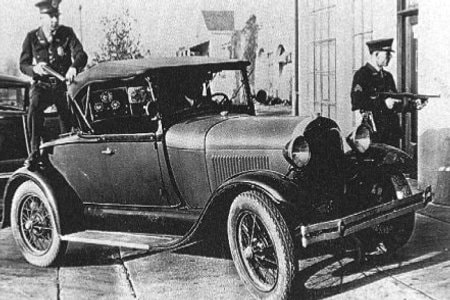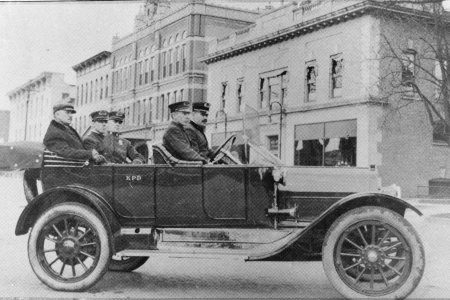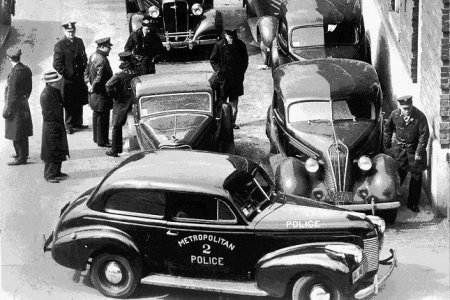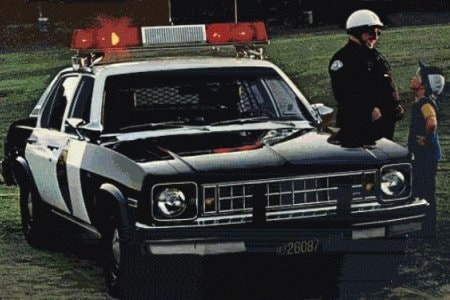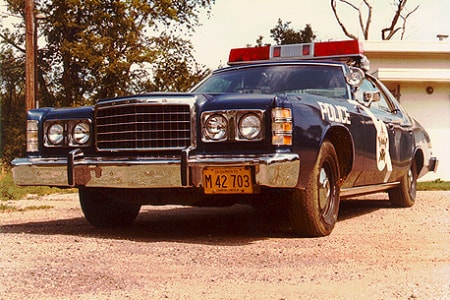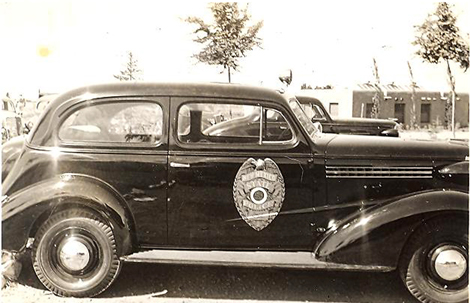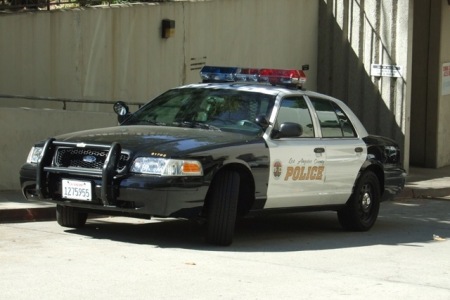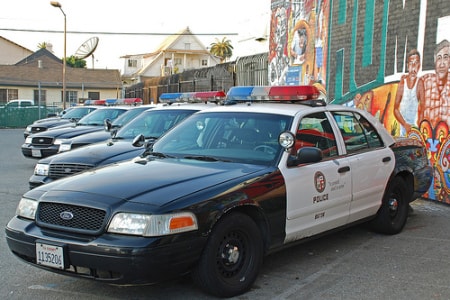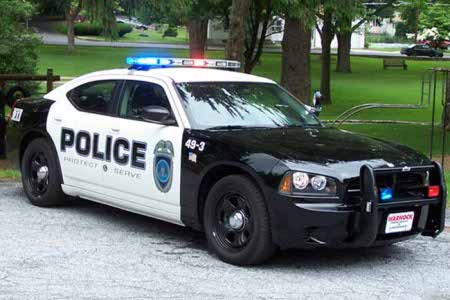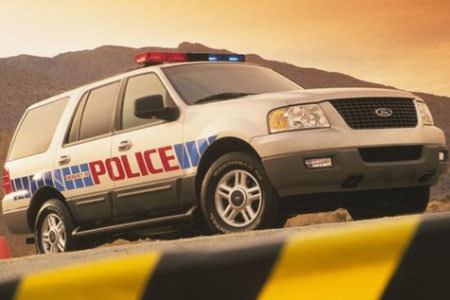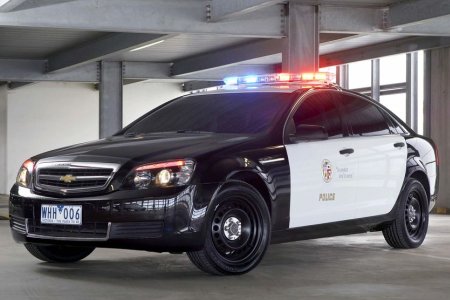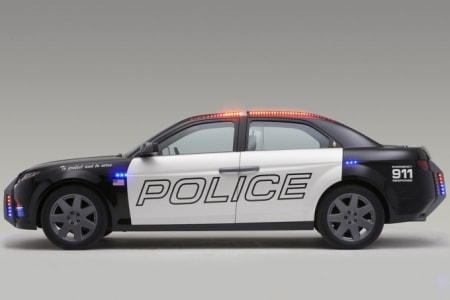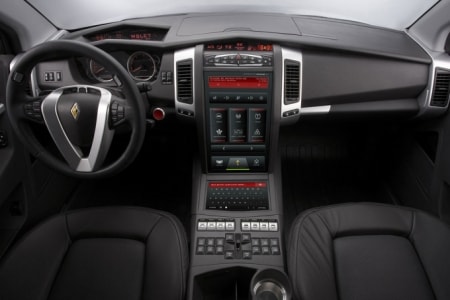One could say that after over a century of chasing crime in an organized form, police should have caught up with it by now. Yet, no matter the means, man power or techniques used to combat crime, law enforcement agencies have never really managed to wipe out that which they fight against.
But at least they try and, as technology advances, the means employed by police departments get better and better. So much so that, since the advent of the automobile, the police car for instance kept evolving and became one of the favorite... everything of any child human male.
We all, at one point, took pride in our fathers being police officers, if that's the case, or we all dreamt at the shinny, noisy, fast police car. Police cars are so loved by toddlers that there is no single Christmas when stores don't fill up with police car miniatures, toys and mockups. An amazing percentage of child play games revolve around police and their antagonists, crooks, with all the mockup weapons, cars and techniques that go with them.
Sure, once in adulthood, the fascination with police cars somewhat splits. Some keep it and go on to become police officers. Some begin loathing them and turn criminals. Most put this fascination aside, but not quite get over it. No matter what you become in your adult life, the sight of a police car triggers some type of reaction and almost never passes unnoticed.
This is why we thought to give you a presentation of how the whole thing started, where it is now and, as much as possible, show you the direction in which it is heading.
EARLY HISTORY
The concept of law enforcement, even if present in the human society for millennia, has not really began taking off until the beginning of the 20th century. As was the case with just about every single other field of the human life, the technical advancements made law enforcement move, in just a few decades, from chasing bank robbers or such on the horses' back to speeding after them in more and more advanced vehicles.
Of course, back in 1899, when the first documented use of a self-propelled vehicle for police business took place in the US, no one really knew where it will eventually lead. At the turn of the 19th century, police officers began using electrically-powered wagons, but only as a mean of transport for them (hence the name squad car for today's police cars). This reportedly first happened in Akron, Ohio, in the aforementioned year. There are no records of how the vehicle performed, or what it managed to do.
At first, early vehicles were used as a means to allow officers to get to the scene of a crime faster. Even in their crude state, they started being used for patrol purposes, with the so called supervisors moving around the city to monitor their respective patrol districts.
Slowly, the fast-growing automotive industry engulfed law enforcement efforts as well. The road opened by Ford's Model T was the signal for police departments to go the motorized way. The T became as popular with police agencies because they were cheap and just about the single viable choice at the time.
The early versions of the T were powered by a front mounted 2.9l four cylinder engine, developing a tiny troop of only 20.2 hp. This gave it a top speed of at most 45 mph (75 km/h) and ate as much as 18.7l of fuel every hundred kilometers (13 mpg). Despite this, being the only true choice on the market made the T go into service with just about every law enforcement agency in the country by the 1920s.
Concomitantly, the so called paddy wagons began being used. The vehicles were enclosed bed trucks, used to carry both police officers and criminals.
Regardless of the vehicle chosen to be used for police work up until the 1920s, they had one big advantage, which also happened to be their huge disadvantage. A vehicle is faster than a horse, and definitely much faster than a human on foot, a trait which makes it ideal for chasing bad guys across the state.
But how could one chase someone effectively, if one doesn't know who they are, where they are, where they're heading and what they have done? Being fast and mobile meant police spent more time on the field, but this it turn left them with no actual means of communicating with the HQ or with other police officers. Moving in packs of two or more vehicles was as equally ineffective, as the main purpose of the police car was to allow police to cover more ground, faster.
Created, in its modern form, by Senior Constable Frederick William Downie from the Victorian police in Australia, the two-way radio was the first means of communications which used no wires to transmit data. The Victorian police was the first one in the world, in 1923, to use such a system in a car, forever replacing the lengthy, ineffective calls via telephone boxes.
In the US, the new technology started taking off in 1929. The Detroit city police began broadcasting on their KOP station in the late 1920s, a move which soon inspired a world's first. In Michigan, following a $25,000 investment in equipment and the support of the Federal Communications Commission, the world's first state-operated police radio came to be, in 1929: station WRDS.
WRDS was just about the only transmitter at the time and its importance exceeded state borders. The station could be heard in 44 State Police cars, some 80 State Police HQs and countless other local police departments.
The advent of a centralized communications system allowed the police car to get to the next level. Whereas up until then cars were used for transport and patrol means, coordination meant they could get a more aggressive stance towards crime. In 1933, a blockade system was established in 41 Detroit-area counties and soon after, interstate-coordination started.
Ever since 1918, when Chevrolet introduced the Model D, a car powered by a V8 engine and developing twice as much power as the T (55 hp), Ford's supremacy began rocking. With the introduction of the over-head valve 6 cylinder engine in 1929, Chevrolet was beginning to threaten Ford's huge slice of the police departments' budgets. But Ford fought back...
The star of the cops and robbers chases became Ford's new flathead V8, introduced by the manufacturer in 1932 on the V-8 model. Equally cherished by the center figures of the "public enemy era" (Bonnie and Clyde or John Dillinger) and the police chasing them, the V-8 would establish high-powered, fast vehicles as the cars of choice for police departments. Also known as Model 18, the V-8 developed over three times as much power as the T used to do, namely 85 hp.
Few, if any markings let the others know a car is being used by police. In the early days, police cars were given just an insignia, stating the car's purpose on the road.
This minor setback, together with the need to make police cars better than their foes', led to the creation of what is now known as a police package. By definition, a police package is the car itself, customized to become a police car and featuring performance, stance and visual enhancements.
One of the first packages to be offered was created by Ford, but only after the end of the second World War. The American manufacturer found there were several, repetitive items, asked by police departments when it came to cars. To make their job easier, Ford selected those features and combined them with several other parts and components, which were then sold to police departments as Police Packages.
Of course, everyone picked up the idea and soon US streets were filled with identifiable police cars. Underneath the fancy painting and lights, however, the packages hid serious improvements to both performance and resistance. Police cars became much more tough and resilient than their regular, street versions.
Police packages also began solving another problem officers had to face. Not being purpose built for police use, cars did not have any means of separating the officers from the prisoners they transported. To make matters worse, until police packages arrived, policemen have reportedly been driving alongside the suspects sitting right besides them, on the front seats.
Police cars began using on a larger scale sirens and lights. The sirens were, in general, a rotating disk powered by an electric motor, while the lights were limited to a red flasher or a Federal Beacon Ray. By the 1960s, the single, rotating light began being replaced with Federal bar mounted dual lights. Towards the end of the decade, enclosed lightbars began being manufactured, sticking with police cars to the modern day.
Larger police departments started separating themselves from the regular trend and asked their cars be painted in two, contrasting colors, to be fitted on the doors and front/rear fenders.
Plymouth, one of the favorite choice of police departments, took police packages even further and came up with an advertising campaign to promote their products. They even began building several packages, to suit the needs of different law enforcement agencies. Chrysler replied with the release of the Dodge Coronet police package, in 1956, followed by the Dodge Dart Pursuit in 1959.
The American police's taste in terms of cars thus began taking shape. Even since the 1932 Ford V-8, the appeal of law-defenders for muscle cars grew. By the 1970s, just about the entire fleet of police cars was a force to be reckoned with, spearheaded by 300+ hp engines.
The shift in taste culminated with some call "the ultimate police car" of the '70s (and since), the Chevrolet Nova Police package. Surfaced in 1975, the code-named 9C1 was powered by a LM1 350-cid, four-barrel carbureted V8 engine, developing 155 hp.
Unfortunately, the end of the 1970s, the oil crisis which was about to ensue and the stricter emission regulations slowly pushed big engines out of the cars and, consequently, out of the force.
By early 1980s, big engines were nearly extinct and police departments had to turn to the likes of Ford Fairmont or Plymouth Volare. Most of the police-spec vehicles were the same with the ones built for taxi use.
By mid 1980s, the different ways and agencies to use police cars made for the creation of the current classes of police cars. The advent of the Sport Utility Vehicle (SUV) also opened the doors for government agencies to set themselves apart from regular police forces.
Since the 1990s, police cars can be classified in police pursuit vehicles (PPV), special service vehicles (SSV) and special package vehicles (SSP).
The police pursuit vehicle is the everyday patrol car of a police precinct. It is fully equipped to handle just about every single type of situation, from regular traffic stops to high speed chases and road blocks.
The special service package vehicles, mostly used by government agencies, are specially equipped SUVs, while the special service package ones come in the shape of sports cars.
Of course, basically every type of vehicle out there can be used by the police. In modern days, police also conduct surveillance work and using a marked police vehicle isn't as inconspicuous as using an unmarked one. Whether it is a plain old Chevrolet Impala or a Hummer H3, a cars used by police during a so called sting is all law enforcement needs to catch criminals in the act.
Manufactured by Carbon Motors, recently settled in Connersville, Fayette County, Indiana, the E7 will become the only one of its kind in the world. It packs a 3.0l turbodiesel V8 engine, developing 300 hp and 420 pound-feet of torque. It has an acceleration time of 6.5 seconds, a top speed of 250 km/hour and a city/highway fuel consumption rating of 28-30 mpg (12-13l/100 km).
And if you are a criminal and think the E7 is just a passing mood, you're wrong. With the help of some very neat engineering, as well as with the support of some well placed friends, the E7 will fill the streets, by the tens of thousands, starting 2012. Back in July, when we last heard from Carbon, they were pleased to announce they have some 10,000 reservations for the upcoming police cruiser.
Of course, back in 1899, when the first documented use of a self-propelled vehicle for police business took place in the US, no one really knew where it will eventually lead. At the turn of the 19th century, police officers began using electrically-powered wagons, but only as a mean of transport for them (hence the name squad car for today's police cars). This reportedly first happened in Akron, Ohio, in the aforementioned year. There are no records of how the vehicle performed, or what it managed to do.
At first, early vehicles were used as a means to allow officers to get to the scene of a crime faster. Even in their crude state, they started being used for patrol purposes, with the so called supervisors moving around the city to monitor their respective patrol districts.
Slowly, the fast-growing automotive industry engulfed law enforcement efforts as well. The road opened by Ford's Model T was the signal for police departments to go the motorized way. The T became as popular with police agencies because they were cheap and just about the single viable choice at the time.
The early versions of the T were powered by a front mounted 2.9l four cylinder engine, developing a tiny troop of only 20.2 hp. This gave it a top speed of at most 45 mph (75 km/h) and ate as much as 18.7l of fuel every hundred kilometers (13 mpg). Despite this, being the only true choice on the market made the T go into service with just about every law enforcement agency in the country by the 1920s.
Concomitantly, the so called paddy wagons began being used. The vehicles were enclosed bed trucks, used to carry both police officers and criminals.
Regardless of the vehicle chosen to be used for police work up until the 1920s, they had one big advantage, which also happened to be their huge disadvantage. A vehicle is faster than a horse, and definitely much faster than a human on foot, a trait which makes it ideal for chasing bad guys across the state.
But how could one chase someone effectively, if one doesn't know who they are, where they are, where they're heading and what they have done? Being fast and mobile meant police spent more time on the field, but this it turn left them with no actual means of communicating with the HQ or with other police officers. Moving in packs of two or more vehicles was as equally ineffective, as the main purpose of the police car was to allow police to cover more ground, faster.
THE THING THAT MADE THE DIFFERENCE...
... was the two-way radio. This apparently plain gadget allowed police cars to really take off.Created, in its modern form, by Senior Constable Frederick William Downie from the Victorian police in Australia, the two-way radio was the first means of communications which used no wires to transmit data. The Victorian police was the first one in the world, in 1923, to use such a system in a car, forever replacing the lengthy, ineffective calls via telephone boxes.
In the US, the new technology started taking off in 1929. The Detroit city police began broadcasting on their KOP station in the late 1920s, a move which soon inspired a world's first. In Michigan, following a $25,000 investment in equipment and the support of the Federal Communications Commission, the world's first state-operated police radio came to be, in 1929: station WRDS.
WRDS was just about the only transmitter at the time and its importance exceeded state borders. The station could be heard in 44 State Police cars, some 80 State Police HQs and countless other local police departments.
The advent of a centralized communications system allowed the police car to get to the next level. Whereas up until then cars were used for transport and patrol means, coordination meant they could get a more aggressive stance towards crime. In 1933, a blockade system was established in 41 Detroit-area counties and soon after, interstate-coordination started.
V8 MUSCLE
On the parallel front, the vehicles themselves were turning into forces to be reckoned with. By the 1930s, there were three major players competing for a place in police garages: Chevrolet, Ford, and Plymouth.Ever since 1918, when Chevrolet introduced the Model D, a car powered by a V8 engine and developing twice as much power as the T (55 hp), Ford's supremacy began rocking. With the introduction of the over-head valve 6 cylinder engine in 1929, Chevrolet was beginning to threaten Ford's huge slice of the police departments' budgets. But Ford fought back...
The star of the cops and robbers chases became Ford's new flathead V8, introduced by the manufacturer in 1932 on the V-8 model. Equally cherished by the center figures of the "public enemy era" (Bonnie and Clyde or John Dillinger) and the police chasing them, the V-8 would establish high-powered, fast vehicles as the cars of choice for police departments. Also known as Model 18, the V-8 developed over three times as much power as the T used to do, namely 85 hp.
SETTING THEM APPART
As the use of cars for police purposes picked up, so did chases, roads blocks and any other type of hood-to-hood confrontation. For the innocent, captivated bystander however, it was not always clear who is chasing who. As Henry Ford said, "any customer can have a car painted any color that he wants so long as it is black." Although the palette was more diverse than that, the color of choice for both police officers and criminals alike remained black.Few, if any markings let the others know a car is being used by police. In the early days, police cars were given just an insignia, stating the car's purpose on the road.
This minor setback, together with the need to make police cars better than their foes', led to the creation of what is now known as a police package. By definition, a police package is the car itself, customized to become a police car and featuring performance, stance and visual enhancements.
One of the first packages to be offered was created by Ford, but only after the end of the second World War. The American manufacturer found there were several, repetitive items, asked by police departments when it came to cars. To make their job easier, Ford selected those features and combined them with several other parts and components, which were then sold to police departments as Police Packages.
Of course, everyone picked up the idea and soon US streets were filled with identifiable police cars. Underneath the fancy painting and lights, however, the packages hid serious improvements to both performance and resistance. Police cars became much more tough and resilient than their regular, street versions.
Police packages also began solving another problem officers had to face. Not being purpose built for police use, cars did not have any means of separating the officers from the prisoners they transported. To make matters worse, until police packages arrived, policemen have reportedly been driving alongside the suspects sitting right besides them, on the front seats.
Police cars began using on a larger scale sirens and lights. The sirens were, in general, a rotating disk powered by an electric motor, while the lights were limited to a red flasher or a Federal Beacon Ray. By the 1960s, the single, rotating light began being replaced with Federal bar mounted dual lights. Towards the end of the decade, enclosed lightbars began being manufactured, sticking with police cars to the modern day.
Larger police departments started separating themselves from the regular trend and asked their cars be painted in two, contrasting colors, to be fitted on the doors and front/rear fenders.
Plymouth, one of the favorite choice of police departments, took police packages even further and came up with an advertising campaign to promote their products. They even began building several packages, to suit the needs of different law enforcement agencies. Chrysler replied with the release of the Dodge Coronet police package, in 1956, followed by the Dodge Dart Pursuit in 1959.
The American police's taste in terms of cars thus began taking shape. Even since the 1932 Ford V-8, the appeal of law-defenders for muscle cars grew. By the 1970s, just about the entire fleet of police cars was a force to be reckoned with, spearheaded by 300+ hp engines.
TIDE TURNING
Another major change happened in the beginning of the 1960s, when smaller cars began being used as squad vehicles. As the compact car was slowly making its way into the world, police began turning their attention form the large- and mid-sized sedans.The shift in taste culminated with some call "the ultimate police car" of the '70s (and since), the Chevrolet Nova Police package. Surfaced in 1975, the code-named 9C1 was powered by a LM1 350-cid, four-barrel carbureted V8 engine, developing 155 hp.
Unfortunately, the end of the 1970s, the oil crisis which was about to ensue and the stricter emission regulations slowly pushed big engines out of the cars and, consequently, out of the force.
By early 1980s, big engines were nearly extinct and police departments had to turn to the likes of Ford Fairmont or Plymouth Volare. Most of the police-spec vehicles were the same with the ones built for taxi use.
By mid 1980s, the different ways and agencies to use police cars made for the creation of the current classes of police cars. The advent of the Sport Utility Vehicle (SUV) also opened the doors for government agencies to set themselves apart from regular police forces.
Since the 1990s, police cars can be classified in police pursuit vehicles (PPV), special service vehicles (SSV) and special package vehicles (SSP).
The police pursuit vehicle is the everyday patrol car of a police precinct. It is fully equipped to handle just about every single type of situation, from regular traffic stops to high speed chases and road blocks.
The special service package vehicles, mostly used by government agencies, are specially equipped SUVs, while the special service package ones come in the shape of sports cars.
Of course, basically every type of vehicle out there can be used by the police. In modern days, police also conduct surveillance work and using a marked police vehicle isn't as inconspicuous as using an unmarked one. Whether it is a plain old Chevrolet Impala or a Hummer H3, a cars used by police during a so called sting is all law enforcement needs to catch criminals in the act.
WHAT'S TO COME
All the different models and makes used by police until know will soon be united under one name. For the first time in history, an all purpose-built police car is currently touring the US to get the necessary feed-back from police departments.Manufactured by Carbon Motors, recently settled in Connersville, Fayette County, Indiana, the E7 will become the only one of its kind in the world. It packs a 3.0l turbodiesel V8 engine, developing 300 hp and 420 pound-feet of torque. It has an acceleration time of 6.5 seconds, a top speed of 250 km/hour and a city/highway fuel consumption rating of 28-30 mpg (12-13l/100 km).
And if you are a criminal and think the E7 is just a passing mood, you're wrong. With the help of some very neat engineering, as well as with the support of some well placed friends, the E7 will fill the streets, by the tens of thousands, starting 2012. Back in July, when we last heard from Carbon, they were pleased to announce they have some 10,000 reservations for the upcoming police cruiser.



